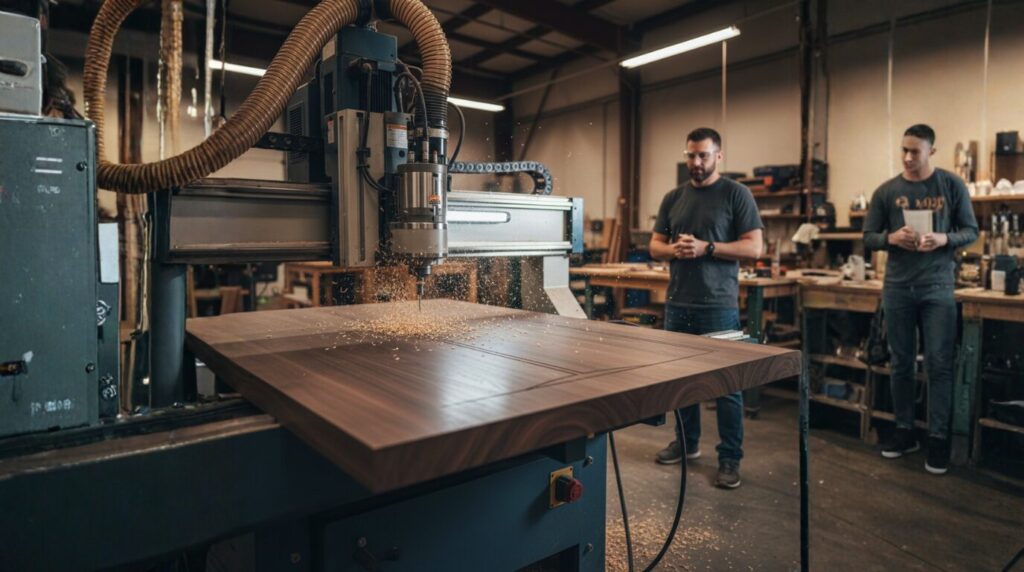Learn how to choose the right CNC machine without confusion or technical overload.
See the key features, types, pros, and cons that matter for real USA manufacturers.
Understand ROI, maintenance, and buying mistakes that beginners often make.
Get practical tips from Etana Corp, a trusted CNC and fabrication machine supplier across the United States.
When buyers from states like Texas, California, Ohio, and New York search for CNC machines, they want accuracy, reliability, and long-term ROI. They also want a machine that fits their shop size, material needs, and production volume. Most importantly, they want a supplier they can trust.

A CNC machine follows a digital design file, moves automatically using programmed commands, and cuts or shapes wood or metal with high precision. The operator loads the material, selects a program, presses start, and lets the machine do the rest.
For manufacturers across North America, from the booming industrial hubs in Texas to the innovative aerospace plants in California, choosing the right CNC (Computer Numerical Control) machine is one of the biggest strategic moves your company will make. It’s not just buying a piece of equipment; it’s an investment in your productivity, precision, and your ability to compete globally. A mistake here can cost you hundreds of thousands in lost production and scrapped material. This guide is designed to clarify the process, ensuring you select the optimal fabrication and machining solution for your shop floor.
Before you even look at a machine’s price tag, you need a clear-eyed assessment of your production requirements. This foundational step dictates everything from the machine type to the necessary power specifications.
Machine Type | Primary Function | Ideal Application |
Laser Cutting Machine (Fiber) | High-speed, high-precision cutting of intricate shapes. | Sheet metal, general fabrication, decorative items. |
Press Brake Machine | Bending and forming sheet metal into precise angles. | Automotive components, enclosures, HVAC parts. |
Punching Machine | High-speed hole creation, notching, and simple shaping. | Electrical enclosures, flat parts, high-volume repetitive work. |
The latest CNC equipment is integrated with Industry 4.0 technology, transforming how manufacturers operate. When investing in a new Fabrication Machine In The United States, focus on these cutting-edge features:
The initial budget often dictates this choice. However, the true cost of ownership is a better metric for the B2B buyer.
Consideration | Investing in New Machinery | Buying Used Machinery |
Initial Cost | Con: High initial capital investment. | Pro: Significantly lower upfront cost. |
Technology | Pro: Access to 2025 features (AI, 5-axis, IoT). | Con: Often lacks modern controls and efficiency. |
Efficiency/TCO | Pro: Higher energy efficiency, lower scrap rate (up to 25% better), and lower long-term labor cost due to automation. | Con: Higher risk of mechanical failure, higher energy consumption, and greater downtime potential. |
Longevity | Pro: Full warranty, 15-20+ years of reliable, high-tolerance service. | Con: Limited or no warranty; remaining lifespan is uncertain. |
Superior Precision & Repeatability: Achieve tighter tolerances, essential for high-value industries like aerospace or defense, ensuring every part is flawless.
Significant Material Waste Reduction: Optimized tool paths and advanced cutting technology mean less raw material scrap, providing major cost savings over time.
High-Volume Production Capability: Automation allows your shop to run more consistently, dramatically increasing your throughput and lowering the labor cost per part.
Modern machines often show up to 25% reduction in material scrap rate compared to older models.
Predictive Maintenance cuts unplanned downtime by an average of 30%.
Clean dust and debris daily
Check lubrication regularly
Tighten loose bolts and belts
Inspect spindle bearings frequently
Keep software and firmware updated
Replace worn parts before they fail
When you’re making a high-ticket investment for your manufacturing facility, you need more than just a box of metal; you need a strategic partner. Etana Corp is dedicated to serving North American manufacturers, offering high-value CNC and fabrication equipment right here in the U.S.
We understand the unique demands of the local market, whether it’s the need for high-speed laser cutting for automotive in Detroit, Michigan, or precision bending for construction projects in Phoenix, Arizona. We take pride in being one of the top fabrication and CNC machine suppliers in the United States, offering the latest technology and localized support that foreign suppliers cannot match. For instance, our range of Fabrication Machines in Texas is curated specifically to handle the high-demand, heavy-duty work common in the Southern U.S.
We offer machines that deliver durability, precision, and the latest in automation.
Ready to upgrade your throughput and precision? Contact Etana Corp today to discuss your production needs and request a personalized quote.
Picking the right CNC machine becomes easy once you know what matters. Whether you work with wood, aluminum, or heavy steel, the right machine helps you work faster, smarter, and with better accuracy.
If you want reliable CNC machines from a trusted U.S. supplier, explore Etana Corp.
Request a Quote Today
Contact Etana Corp for Assistance
CNC mills and fiber lasers deliver the best strength, speed, and accuracy for metal parts.
Focus on material, speed, accuracy, software, and table size.
Starter-level shop CNCs range from budget-friendly to mid-range, depending on speed and accuracy.
CNC routers and small laser machines are easiest for new fabrication business owners.
5-axis CNC machines and fiber lasers lead the industry in speed and high-precision performance.
This blog provides general CNC buying guidance. Always verify machine specs before purchasing.
WhatsApp us